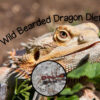Bearded dragon communication comes in a fascinating array of behaviors, despite lacking vocal cords for complex sounds. These reptiles communicate their intentions and emotions through a combination of physical gestures and color changes. Among the most visually striking behaviors are the rapid inflation of their throat pouch, known as a “beard,” and the shifting hues it can display, particularly in males, which can turn their throats black as part of their display.
In the world of bearded dragons, body language is the primary means of communication. They use a series of movements such as head bobbing, arm waving, and beard puffing to convey messages to other dragons. Arm waving can indicate submission, while head bobbing can have different meanings depending on the speed and context, with slow bobs often signifying submission and rapid ones asserting dominance, particularly among males during mating season. These behaviors help maintain social hierarchies, reduce conflicts, and signal reproductive readiness.
Understanding the subtleties of bearded dragon communication is crucial for proper care and management. For those keeping these lizards as pets, recognizing and interpreting their distinctive behaviors can help owners ensure the well-being of their scaled companions. Observing their interactions and responses to different stimuli can prevent stress and aggressive encounters in captivity, creating an environment where these creatures can thrive.
Jump To…
Decoding Bearded Dragon Behavior
Bearded dragons exhibit a range of behaviors that can provide insight into their health, mood, and environmental needs. Understanding these behaviors is crucial for ensuring their wellbeing.
Understanding Behavioral Characteristics
Behavioral characteristics in bearded dragons are often reflections of their health and environmental comfort. Basking is a vital activity; it involves lying under a heat source which aids their digestion and maintains their skin health. Shedding indicates growth and health, as they shed their skin in pieces or sometimes as a whole. If a bearded dragon is not basking or shedding regularly, it may indicate health issues or unsuitable habitat conditions.
The Mysteries Behind Common Behaviors
Bearded dragons may display behaviors that seem unusual but are actually part of their instinctive repertoire. For instance, they love to dig, which in the wild may be a strategy to uncover insects or to create a cool refuge from the heat. Hiding is another common behavior; it provides a sense of security and replicates the shelter-seeking actions they would take in their natural habitat.
Glass surfing, where the bearded dragon repeatedly scratches at the glass walls of their enclosure, could indicate stress or a need for larger space. When a bearded dragon opens its mouth, often termed as gaping, it can be a way to regulate body temperature or a sign of territorial display.
Recognizing these behaviors is crucial for providing a nurturing environment for bearded dragons and can aid in early detection of potential health issues.
Can Bearded Dragons Understand You?
Bearded dragons exhibit a range of behaviors and body languages that suggest a certain level of understanding of their environment and their human caretakers.
Unlocking the Mystery of Bearded Dragon Communication
Bearded dragons may not understand human language, but they are quite adept at communicating through a series of body language signals and movements. For instance, slow arm waving where the arm goes above its head in a circle is considered a submissive gesture. The bearded dragons arm waving in this slow circular movement signals acknowledgment and ‘don’t hurt me’. However, a fast less extensive wave of the forehand along with head bobs is more likely a sign of aggression (Brattstrom. 1971).
Nodding indicates dominance or acknowledgment of the owner’s presence. These physical behaviors, along with eye movements and head bobbing, play a critical role in their social interactions.
Vocalizations and Silence
Relative to many other animals, bearded dragons are generally quiet, lacking the vocal cords that enable complex sounds. However, they can make noises, such as hissing when threatened or defensive. While they may not vocalize extensively, it is said that they can sometimes produce softer sounds in close proximity, like a quiet snoring when sleeping, indicating a level of vocal communication despite the absence of typical vocal cords.
Reading Bearded Dragon Body Language
Understanding the body language of bearded dragons is essential for assessing their emotions, mood, and well-being. Observing these behaviors helps in identifying signs of contentment, stress, or discomfort. Being cold-blooded reptiles, they rely extensively on body language to communicate.
- Wagging Tails: A slow wag may indicate cautious curiosity, while vigorous wagging could be a sign of agitation.
- Head Bobbing: Often a display of dominance or a mating ritual. Frequent, rapid bobs indicate that the dragon feels assertive or even aggressive.
- Shaking: If they tremble or shake, it could be a sign of a health issue, rather than a form of communication.
- Head Down: A submissive gesture that may signal stress or a desire to avoid confrontation.
- Waving: A slow, circular movement of the arm that signals submission or acknowledgement of another dragon’s presence.
- Swaying/Swaying: When accompanied by hissing, can indicate a defensive posture to deter perceived threats.
- Eye Bulging: May occur during shedding to help loosen the skin around the head, or as a sign of dominance.
- Pancaking (Flattening Body): A behavior displayed when they are scared or threatened, making them appear larger to a predator.
- Stamping: Rare and may indicate severe agitation or an attempt to intimidate.
- Yawning: Often just a sign of stretching their jaw, but if frequent, it could suggest stress.
- Rubbing/Glass Surfing: The act of scratching at the glass of their enclosure can signal a desire to explore or indicate that the environment is not meeting their needs.
By observing these actions, owners can better understand and cater to their bearded dragon’s needs, ensuring a happier and healthier pet.
Bearded Dragon Communication with Color
Bearded dragons demonstrate a range of behaviors to communicate with each other, and one of the most fascinating is their use of color. These reptiles can exhibit various colors for different purposes.
Color Changes: The central bearded dragon, Pogona vitticeps, is especially known for its ability to change color. While it is a common belief that reptiles change color only for camouflage, bearded dragons use color to convey complex messages to other dragons and even to humans.
- Dominance and Submission: During social interactions, bearded dragons might display more vibrant colors to express dominance or darken their colors when submitting.
- Health and Stress: Their colors can also indicate health or stress levels. For instance, a bearded dragon might become darker when cold or feeling unwell.
Color Regions to Note:
- Beard: The beard of a bearded dragon can turn black indicating stress or aggression.
- Body: Color changes in the body can be a sign of beardies regulating their temperature.
Research by Herera (2012) suggests that color diversity in the Puerto Rican anoles likely evolved as a means of contrast against the habitat or for differentiation amongst species through dewlap colors. Similarly, bearded dragons use their throat’s color, particularly during mating displays or territorial disputes.
It is important to note that unlike humans, bearded dragons do not have vocal cords for producing a variety of sounds. Instead, their primary mode of communication is visual, which includes body postures and color displays.
Understanding bearded dragon color communication can enhance the effectiveness of care and interaction with them, allowing for the recognition of social behavior and health indications.
Behaviors in Courtship and Mating
Courtship behaviors include mounting, neck and head biting, and various postures during mating. The male may flap its front legs during these interactions, and the female’s response, such as raising her head, can signal the end of mating. Post-mating behaviors include specific bobs and rolls of the head by both males and females (Brattstrom. 1971).
Fight Dynamics
Fight sequences among bearded dragons vary but often follow a pattern of threat displays, physical posturing, and sometimes actual physical contact like biting. The outcome of these fights can influence the social hierarchy within a group.
Submissive gestures, such as submissive waves or postures, can end a fight and are more commonly observed in younger or smaller individuals (Brattstrom. 1971).
Chemical Communication
Bearded dragons and other lizards rely on chemical signals for a myriad of social behaviors such as territory establishment and mating rituals. These signals are often secreted from specialized glands and are detected by the vomeronasal organ or olfactory system in other lizards.
Social Functions: Chemical signals serve as a non-visual means for lizards to communicate information, particularly in environments where other modes of communication may be less effective. For instance:
- Territorial Markers: Lizards leave chemical indicators to delineate territory bounds.
- Reproductive Cues: Pheromones play a role in attracting and repelling potential mates.
Glandular Sources: Chemical signals in lizards originate from several types of epidermal glands. The most notable include:
- Femoral Glands
- Precloacal Glands
- Cloacal Glands
These glands secrete a variety of compounds that carry information relevant to social interactions.
Detection Methods: Lizards possess acute chemosensory systems that detect these signals.
- Vomeronasal Organ: Specialized for pheromone detection.
- Olfactory Receptors: Aid in the interpretation of complex environmental chemical cues.
Neuroendocrine Influence: Arginine vasotocin (AVT), akin to vasopressin in mammals, may regulate these chemosensory behaviors. Research suggests AVT could alter the activity and sensitivity of chemosensory receptors, potentially influencing social behaviors in lizards. Various studies have highlighted the impact of AVT on behavioral responses to conspecific chemical signals, indicating it modifies chemosensory communication and social interactions.
Future Directions: Despite the presence of AVT-ergic systems, little is known about the specific sites where AVT modulates sensorimotor responses to chemical stimuli. More research could unveil how this hormone affects communication in reptiles, with notable implications for understanding the evolution of social behaviors across other vertebrates as well.
References
Hereha, V. (2012). The Use of Color Vision & Color Communication in Lizards.
Brattstrom, B. H. (1971). Social and Thermoregulatory Behavior of the Bearded Dragon, Amphibolurus barbatus. Copeia, 1971(3), 484.






